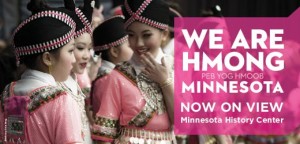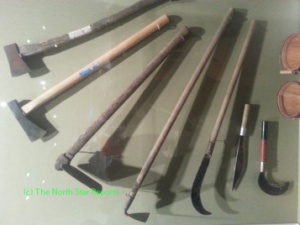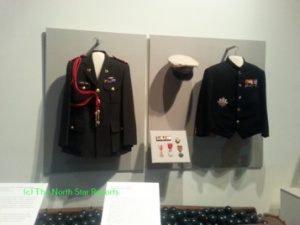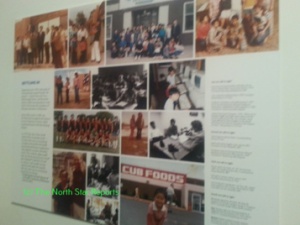We are Hmong Minnesota Exhibit — The North Star Reports – by Bao Vang. Sponsored by The College of St. Scholastica and The Middle Ground Journal
[Main poster, found on google, used to advertise the Hmong exhibit]
Over spring break of 2015, went to the “We are Hmong (Peb Yog Hmoob) Minnesota” at the Minnesota History Center in St. Paul. The event celebrated the 40th anniversary of the Hmong’s migration to Minnesota. I attended the event with my parents, who were part of migration after the Vietnam War in Southeast Asia. It was a great experience to see actual pictures and artifacts that date back to how life was like before, during, and after the war. The exhibit helped me understand some of my parents’ unusual behaviors that I noticed while I was growing up. For example, I now know why my parents have a big obsession with gardening/farming and why there is a collection of bamboo baskets stored the basement that has never been used before. Furthermore, after the exhibit I have learned to value and appreciate my family’s history, the history of the Hmong people, and their journey in North America.
Gardening/farming was the main occupation that many Hmong people had when they lived in Southeast Asia. From my parents’ experience, farming was a full-time job consisting of about eight hours of farming plus another four to six hours of walking to and from the farm. That would be a total of twelve to fourteen hours of transportation and farming every single day.
My parents’ farm in Laos was not close to home, so they would get up every day and walk about three hours to get to the farm before sunrise. After farming all day, they would head back to the village during sunset to get home before dark and then the farming routine was repeated the next day. Due to my parents’ upbringing as farmers, this fact/experience explains why my parents have a big passion for farming. To them, farming is a way to remind them of how life was like in Laos.
Here is an image of common household items found in a Hmong household in Southeast Asia. All of the items are made out of bamboo that was woven together to produce strong baskets for storing rice and farming produce. Brooms are also made out of bamboo to ensure strong bristles for collecting dirt when sweeping the floor.
In my parents’ house in the Twin Cities, they have at least one of each items in the above photo stored in the basement. The items in my parents’ house were bought from Hmong markets that were all handmade by elders in the Hmong community in St. Paul. My parents used the broom a couple of times in the house, but the other items have never been used. . I asked my parents why the items are stored and not used. They mentioned that the bamboo items are a collection to give away as presents to me and my siblings on our respective wedding days. It is also a way to remind us of our cultural roots and where our ancestors came from.
These two outfits were some of the military uniforms worn by Hmong soldiers during the Secret War. The exhibit also displayed the actual medals of two well-known Hmong soldiers: Touby Lyfoung and Col. Ly Teng ( though I am not one-hundred percent sure/ certain if these two well-known soldiers’ medals are displayed in this photo or in another section of the exhibit).
This is a display of some of the artillery remains collected from the Ho Chi Minh Trail, which was the location that had the most bombing activities.
This is a photo of the bus transportation in Thailand where Hmong and other refugees were transported to the airport. Planes flew them to North America, Europe, and Australia. Not all of the refugees were granted transportation to the three locations. Only those who had family members that (who?) served with the U.S. CIA during the Secret War were granted the opportunity to be relocated.
My parents were qualified to come to the U.S. because of my great-grandfather and grandfather’s involvement with the CIA. They mentioned that this was an incredibly long process and a miserable experience. This unpleasantness was due to the amount of people trying to get through. Those who were not qualified to be transported caused a scene, and most of all, many families were split up during this process. My mom got separated from my dad and grandma, but they were able to relocate each other at the airport.
Lastly, this is a board showing the first few photos taken in Minnesota when the Hmong first arrived in the U.S. in 1975. The display consists of multiple images depicting how the Hmong adapted to American life in Minnesota during the late 1970’s. The top photos are Hmong children attending school throughout the Twin Cities area and joining sports teams.
In conclusion, the “We are Hmong Minnesota” exhibit was a phenomenal experience for me. It is a great way to educate the Minnesota community about who the Hmong people are. After seeing what the Hmong people and my ancestors have gone through, I value my culture and identity much more. I am also more appreciative and feel blessed that my parents are doing all they can to remind us not to forget our original roots, as represented by their passion for farming and collection of traditional bamboo baskets as wedding presents.
If you are interested in visiting the “We are Hmong Minnesota” exhibit, please visit http://www.minnesotahistorycenter.org/exhibits/we-are-hmong-minnesota for more details.
Bao Vang serves as Social Media Editor for The North Star Reports and is a student at The College of St. Scholastica.
—
Please contact Professor Liang if you wish to write for The North Star Reports — HLIANG (at) css.edu
See also, our Facebook page with curated news articles at http://www.facebook.com/NorthStarReports
–
The North Star Reports: Global Citizenship and Digital Literacy, The College of St. Scholastica and the scholarly Middle Ground Journal’s online learning community and outreach program with undergraduate and K-12 classes around the world. For a brief summary, please see the American Historical Association’s Perspectives on History, at:
http://www.historians.org/perspectives/issues/2013/1305/Opening-The-Middle-Ground-Journal.cfm
The North Star Reports publishes edited essays from our students, particularly from those who are currently stationed, or will soon be stationed abroad. Students have reported from Mongolia, Southern China, Shanghai, Colombia, Norway, northeastern China, Nicaragua, Micronesia, The Netherlands, Tanzania, Ireland, El Salvador, England, Finland, Russia, Cyprus, and Haiti. We also publish student reviews of books, documentaries, and films, and analysis of current events from around the world. We will post their dispatches, and report on their interactions with the North Star Reports students and teachers. We thank The Department of History and Politics and the School of Arts and Letters of The College of St. Scholastica for their generous financial support for The North Star Reports and The Middle Ground Journal.
Hong-Ming Liang, Ph.D., Editor-in-Chief and Publisher, The North Star Reports; Chief Editor, The Middle Ground Journal; Associate Professor of History and Politics, The College of St. Scholastica.
Kathryn Marquis Hirsch, Managing Editor, The North Star Reports.
(c) 2012-present The North Star Reports: Global Citizenship and Digital Literacy http://NorthStarReports.org ISSN: 2377-908X The NSR is sponsored by The College of St. Scholastica and the scholarly Middle Ground Journal. See Masthead for our not-for-profit educational open- access policy. K-12 teachers, if you are using these reports for your classes, please contact editor-in-chief Professor Liang at HLIANG (at) css.edu








Reblogged this on Professor Liang 梁弘明教授.
Reblogged this on The Middle Ground Journal.
I found this article very informative and I learned a lot from it. An interesting quote I picked out was: “They mentioned that the bamboo items are a collection to give away as presents to me and my siblings on our respective wedding days. It is also a way to remind us of our cultural roots and where our ancestors came from”. I felt like this was very important because it shows how deep your family’s roots are. Now that there is an exhibit, like you, I hope more people can learn and come closer to the culture. Nice job!
What a great article. I particularly enjoy the history that you bring to mind. It is important to remember that Minnesota has a large Hmong population as well as how and why they came here. I think that it is great that you have written an article to discuss some important things about a people and culture that have become central to Minnesota. Also the exhibit and objects look awesome and very informative!
This article was wonderful! I do not know much about Hmong culture, so these tidbits of knowledge give me a better understanding. I can not believe how far your parents had to walk everyday, that is pure dedication and will power. It must have been quite the transition moving to Minnesota, and I hope they are still able to garden as much as they please! Great job.
I am happy this museum exhibit allowed you to feel a stronger connection to your roots and your parents. Sharing moments like this are important to pass on stories and customs of one’s culture. Great pictures too, they add a lot to the history and imagery you talk about. I don’t know much about the Hmong culture, but I greatly enjoyed learning about your parent’s lives and culture in you article.
Your article was a very interesting combination of both history and family. I think it is so important for everyone to know about the histories of the different cultures living here. Family history is also so fun to learn, especially learning it directly from those who lived it, because it sometimes explains the quirks of the family.
Thank you for writing this piece! I think it’s amazing to learn about my friends’ cultures. I knew very little about Hmong culture before, but now I feel I have seen a glimpse. To me it’s important to learn about the cultures of those living in communities, cities, and states that are familiar to me. The story of what lead up to the migration is so interesting and tragic too. This was well written and I appreciate the inclusion of photos to illustrate your points!
This is an awesome article! When reading I was fascinated when it came to the history and culture of the Hmong. Going through school we never really looked at Hmong culture and the secret war, so it was very interesting to learn about this exhibit. When you started to talk about your parents saving the bamboo baskets for you and your siblings wedding day just shows people will always have their culture and traditions to pass down no matter where they are. Great Article!
The fact that your parents walked to a farm 3 hours away is incredible to me! What strong and incredible people! I wonder how their transition to Minnesota effected them, emotionally and also in their line of work. I bet they also enjoyed this exhibit. How interesting that you also have some of these farming tools in your basement!
This was a very fun and interesting article to read! It is wonderful that your parents are planning on giving you the bamboo baskets on your wedding day as a way to connecting you to your past, or as you stated, original roots and that you are appreciative of this. It must have been a very valuable experience for you to learn about the difficulties your parents had in their journey to America. After reading your article, I feel a desire to learn more about my own heritage. Thank you for sharing!
Bao
Thanks for the wonderful pictures as well as your insight. I truly appreciate your insight into Hmong culture and the connections you were able to make. Side bar, I look forward to traveling to China with you in just a few short weeks!
This article reminds me how important cultural experiences and memories are, even in locations where they are asked to be forgotten about and abandoned (in some circumstances). While some of us may not be fond of particular memories such as working 12+ hours every day, doing back-breaking work, your parents show that despite the pain and suffering involved, the experience of doing farm work was worth it. Do they talk favorably about the work itself, or just the memories of it?
The amount of history that a group of people can have after traveling such a far distance compels me to imagine what struggles those people have overcome to sustain the roots that were started and grow from them. The article does a great job of displaying a people and their culture. The exhibit looks like a lot of work was put in to produce an extraordinary result!
Considering all the talk about refugees in the news the last few months, this was a very timely piece to read. Thanks for sharing it! This must have been a cool experience for you and your family. However, I am curious: how did your parents react to seeing their culture and identity displayed in a museum?
I love how you intertwined your family history with the things you learned at the exhibit! It sounds like the exhibit was wonderfully done, and I wish we would learn more about other groups of people coming to settle in Minnesota besides those from Sweden, Finland, or Norway. I hope it wasn’t too difficult for your parents to transition to life in the U.S.!
What a great and interesting exhibit! I would love to see it sometime. The traveling that some people had to do sounds terrifying. I can’t imagine what it would be like to be separated from family like that. Thanks for sharing with your wonderful insight!
This is an extraordinary exhibit that I hope I can see sometime soon! I can’t imagine what it would be like to be split up a family in order to go to the US. My family also has family tools and ‘relics’ that will be passed onto me when I begin a family myself, I am looking forward to the day I get those. Thanks for sharing and your insight!
I am glad that you were able to reach out and see your family roots. It is important that people remember their history and backgrounds otherwise you lose a part of yourself. It was very interesting to learn a little bit about the Hmong culture. You are so lucky to have such a great experience.
Cool article! I actually grew up with Hmong neighbors and it’s cool getting to know them over the years. It’s so cool that events like this are so accessible so that we can learn new things and have new experiences.
Connecting back to your roots sounds like an awesome experience. The idea that your parents do not use the bamboo tools in the garden because they will be given and gifts is very cool because of the deeper meaning they must have. I couldn’t image having my family split up when leaving a country and maybe not being able to find them again, i’m glad it worked out for your parents. Thank you for sharing!
Your parents sound like amazing and hard working people. I also love how they like to keep strong ties to their heritage with the storing of the bamboo baskets and such to give to their children as wedding gifts. It shows how much they cherish their culture and traditions. It sounded like a lot was learned about who you are and where you came from by visiting this exhibit. It’s always interesting to learn about one’s familys upbringing.
This was a lovely read! The Hmong culture is one I am not very knowledgeable about and it’s always great to learn more about it. I’m so happy that you were able to feel a greater connection to your culture through this exhibition. My favourite section of this article was reading about the farming as it was astounding and impressive how dedicated your parents were (and I’m sure, are) to that aspect of their lives. Thank you so much for sharing!
I learned about this exhibit in my Migration and Diaspora class offered here at CSS. Unable to make it to the exhibit I really appreciate this review. Growing up near the Twin Cities our schools taught some about the history, struggle, sacrifice, and bravery of the Hmong people. To see Minnesota embrace Hmong culture in such a positive way makes me feel really proud. Knowing what the families of some of my childhood friends had to go through it is moving to know that their tales, and many other family’s tales, are being told. Thank you for sharing a little bit of your and your family’s experience as well!
This article’s reference to Hmong relocation after the Vietnam War is particularly relevant to today’s discussion about immigration. The article mentions only people with family who served with the U.S. in the war could relocate to the U.S. One aspect of immigration that’s frequently overlooked is the relocation of Iraqis and Afghans who assisted the U.S. in recent wars. Many people risked their lives to help the U.S. army with translating and intelligence gathering. Not only do we have a moral obligation to relocate these people, but it’s in the interest of national security to protect our allies. As this article shows, immigration can have a long-term cultural influence on an area. Today I think Minnesotans have a greater appreciation of other cultures because of the Hmong people.
Thank you for sharing your experiences with us! I had always had a fascination with the Hmong culture because they are not really talked about and is viewed as a minority out of all the Asian groups. This article reminds me of my parent’s migration after the Vietnamese War. My dad was from North Vietnam, he escaped my boat to Indonesia’s refugee camp. My mom flew out of Vietnam to the United States by her brother being her sponsor. My mom’s brothers had to escape earlier so they weren’t drafted in the war. I believe everyone has their own stories to tell about where they came from. It is important to know one’s roots, as well as understand their cultures and rituals.
I loved the photos in the article and they articulate way you tied the things you have learned to the real life experience of your family. I missed an opportunity for hands on learning of the Hmong people of MN, but I did take a class that was directly focused on the Hmong and Somali diasporas in MN. These peoples have a lot of cross over in the after effects of migration and seeking refuge in MN. I think it is wonderful that your family was able to keep some of the artifacts from their home country and traditional culture. I also learned about the Secret War and I think this story is heartbreaking and should be more commonly taught in the education system. It is also relevant that your family and many other Hmong people have a tradition of farming because a lot of Hmong people are involved in the agricultural business in MN and they often dominate farmers markets in the Twin Cities, but also north of the Twin Cities which is where I am from. This knowledge of farming and the available market for agriculture was most likely a pull factor towards MN.
This was such a great article. The photos that you included were helpful in understand the things that you talk about. I had a ton of Hmong friends in high school, and it is nice to see that they are getting attention after all that they have gone through as a group. The immigration that they were forced to go through i feel is very important to today’s world. Because while it is not the same, they are very similar, and it is something that we have done well in the past. I just hope we look back and see the good that immigrants can do and how helpful they are in the communities they live in.